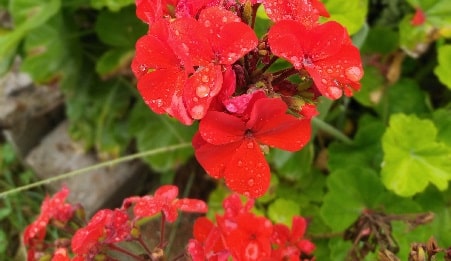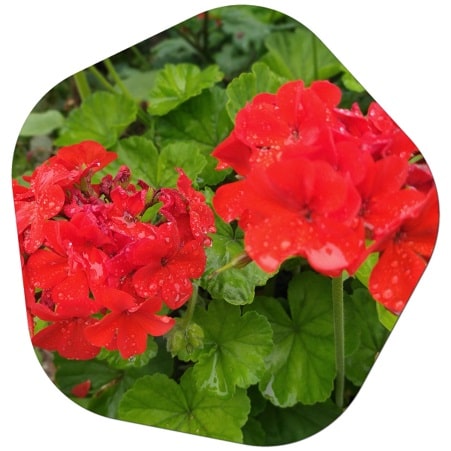(Pelargonium hortorum) Are geraniums native to America?
Where is geranium native? It is a perennial plant whose homeland is South Africa. It is so widely cultivated in Mediterranean countries that it has become synonymous with the Mediterranean. Characteristics of the geranium flower, Its homeland is South Africa. It was recognized in Europe around 1700. It is a perennial herbaceous or semi-herbaceous shrub. The flowers are multicolored and variegated or solid colored, and the corolla of the flowers can be simple or layered. Is geranium perennial? Geranium belongs to the cranesbill family. It is a perennial plant native to South Africa.
Geraniums (Pelargonium hortorum) are not native to America. They actually originate from South Africa. Geraniums were introduced to Europe in the 17th century and became popular ornamental plants. They are now widely cultivated and found in gardens and containers around the world, including in America. However, it’s important to note that the term “geranium” is often used to refer to two different plant genera: Pelargonium and Geranium. Pelargoniums, including Pelargonium hortorum, are the plants commonly referred to as geraniums in gardening and horticulture, but they are not true geraniums. True geraniums are a separate genus of plants and include various species that are native to different regions of the world, including America.
Where does geranium grow in the United States?
Geraniums (Pelargonium hortorum) are widely grown as ornamental plants in the United States. They are popular for their colorful flowers and ability to thrive in a variety of climates. Geraniums are typically cultivated as annuals, meaning they are planted and enjoyed for one growing season before being replaced.

Geraniums can be grown throughout the United States, but their performance may vary depending on the specific climate and growing conditions. They generally prefer full sun or partial shade and well-draining soil. Here are some common places where geraniums can be found growing in the United States:
- Gardens: Geraniums are commonly grown in home gardens and public gardens across the country. They are often used in flower beds, borders, containers, and hanging baskets to add vibrant color and texture to the landscape.
- Parks and Landscapes: Many parks, botanical gardens, and public landscapes feature geraniums as part of their floral displays. They are often planted in flower beds and containers to create attractive floral arrangements.
- Commercial Nurseries and Garden Centers: Geranium plants and cuttings can be purchased from commercial nurseries and garden centers throughout the United States. These establishments offer a variety of geranium cultivars and colors for home gardeners and landscaping projects.
- Hanging Baskets and Window Boxes: Geraniums are popular choices for hanging baskets and window boxes due to their cascading growth habit. They are often seen adorning balconies, porches, and windowsills, especially in warmer regions.
- Greenhouses and Conservatories: Geraniums can be found in greenhouses and conservatories, particularly in colder regions, where they are grown year-round or during the winter months.
It’s worth noting that the specific cultivars of geraniums available and preferred for cultivation may vary by region and personal preference.
How to Care for the Arch Geranium Flower?
Geraniums (Pelargoniums) are popular flowering plants that are relatively easy to care for. Here are some general guidelines for caring for geranium flowers:

- Sunlight: Geraniums thrive in full sun to partial shade. They prefer at least 4-6 hours of direct sunlight each day. Place them in a location with ample sunlight exposure.
- Watering: Geraniums prefer moderate watering. Water the plants when the top inch of soil feels dry to the touch. Avoid overwatering, as it can lead to root rot. Ensure proper drainage to prevent waterlogged soil.
- Soil: Geraniums prefer well-draining soil. Use a lightweight, porous potting mix or amend garden soil with organic matter to improve drainage. Avoid heavy clay soils that retain too much moisture.
- Fertilization: Feed geraniums with a balanced, water-soluble fertilizer every 4-6 weeks during the growing season. Follow the instructions on the fertilizer packaging for proper dosage. Be careful not to over-fertilize, as it can result in excessive foliage growth at the expense of flowering.
- Deadheading: Remove spent flowers regularly by pinching or cutting them off just above a leaf node. Deadheading promotes continuous blooming and prevents seed formation.
- Pruning: Trim leggy or straggly stems to encourage bushier growth. Pinch back the growing tips of the stems to promote branching and more flower production.
- Winter Care: In colder regions, geraniums are often treated as annuals or brought indoors during the winter. Before the first frost, dig up potted geraniums or carefully lift them from the ground, prune them back, and store them in a cool, dry place for the winter. Water sparingly during this period.
- Pest and Disease Control: Monitor for common pests like aphids, whiteflies, and spider mites. If infestations occur, treat them with insecticidal soap or horticultural oil. Avoid overwatering to prevent fungal diseases. If necessary, use fungicides labeled for geraniums.
Remember, specific care requirements may vary depending on the geranium variety and your specific growing conditions. It’s always a good idea to consult local gardening resources or a nursery for specific care instructions based on your location.
Information about the geranium flower in America
Geraniums (Pelargoniums) are widely grown and cherished as ornamental plants in America. They are valued for their vibrant flowers, diverse color options, and ease of care. Here is some information about geranium flowers in America:
- Popular Cultivars: There are numerous cultivars of geraniums available in America, offering a wide range of flower colors, sizes, and growth habits. Some popular cultivars include ‘Maverick,’ ‘Caliente,’ ‘Rozanne,’ ‘Americana,’ and ‘Patriot.’ Each cultivar may have its own unique characteristics, such as flower color variations, trailing or upright growth, or heat tolerance.
- Growth Habit: Geraniums can be classified into two main types based on their growth habit: zonal geraniums and ivy geraniums. Zonal geraniums (Pelargonium hortorum) have upright growth with large, round flower clusters, while ivy geraniums (Pelargonium peltatum) have trailing stems with smaller flowers. Both types are widely cultivated and appreciated in America.
- Flower Colors: Geraniums display a variety of flower colors, including shades of red, pink, white, salmon, orange, and lavender. Some cultivars may have bi-color or variegated flowers as well. The vibrant and long-lasting blooms make geraniums a popular choice for adding colorful accents to gardens, containers, and landscapes.
- Suitable Climates: Geraniums are cultivated in various climates across America. They are well-adapted to both warm and cool regions. In warmer climates, geraniums can tolerate heat and full sun but may benefit from some shade during the hottest part of the day. In cooler climates, geraniums are often treated as annuals or grown in containers that can be brought indoors during winter.
- Versatile Uses: Geraniums are versatile plants that can be used in a variety of ways. They are commonly planted in flower beds, borders, hanging baskets, window boxes, and container gardens. Geraniums also make attractive additions to landscapes, parks, and public gardens.
- Low Maintenance: Geraniums are known for their relatively low maintenance requirements. They are generally drought-tolerant and can withstand dry periods once established. However, regular watering and occasional fertilization can promote healthier growth and more prolific blooming.
- Pests and Diseases: While geraniums are relatively resilient, they may occasionally encounter common pests like aphids, whiteflies, and spider mites. Adequate air circulation, proper watering practices, and regular monitoring can help prevent pest infestations. Some diseases that may affect geraniums include powdery mildew and bacterial leaf spot, which can be managed through proper sanitation and, if necessary, targeted treatments.
Overall, geraniums are beloved flowers in America, appreciated for their beauty, versatility, and adaptability to a wide range of climates. Their attractive blooms and ease of care make them a favorite choice among gardeners and flower enthusiasts across the country. When did geraniums come to the US? >>





